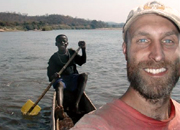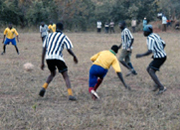FOR IMMEDIATE RELEASE
Monday, June 26, 2006
|
Peace Corps
Contact: Press Office
Phone: 202.692.2230
Fax: 202.692.1379
Email: pressoffice@peacecorps.gov |
|
Daredevil Volunteer Experiences New Thrills in Peace Corps |
|
WASHINGTON, D.C. – It takes courage to jump out of a plane at 1500 feet, fire blazing near your landing point. It also takes courage to leave friends and family for two years to improve not yours, but the lives of others. Lucky for Garrett Olson, he’s got a lot of courage.
As a former smokejumper and now Peace Corps volunteer in Zambia, Olson, 32, has spent his years taking risks that pay off. The Montana native once put out a forest fire after ditching his parachute 60-ft. above ground. Caught in a ponderosa pine tree in the middle of the Santa Fe National Forest, the resourceful Olson rappelled down the pine with rope, ran to the fire, and quelled the danger. How do you beat that rush?
 For starters, try raising HIV/AIDS awareness to the point where fifty villagers out of a few hundred voluntarily get tested. Or, by applying university knowledge of resource conservation, you teach farmers to raise crops on bad soil, thereby increasing their sustenance and economy. Olson accomplished these feats and more as a Peace Corps volunteer in the small village of Kaloko, Zambia. For starters, try raising HIV/AIDS awareness to the point where fifty villagers out of a few hundred voluntarily get tested. Or, by applying university knowledge of resource conservation, you teach farmers to raise crops on bad soil, thereby increasing their sustenance and economy. Olson accomplished these feats and more as a Peace Corps volunteer in the small village of Kaloko, Zambia.
When he was ten years old, he saw the advertisements: “The toughest job you’ll ever love,” though it would be years before he took the challenge as a graduate student at the University of Montana. The life adjustment was monumental.
“I came to Zambia to help, but also to live like a rural Zambian,” said Olson. That meant sleeping in a pounded-mud walled hut without electricity, running water, transportation, or communication. “My water source is a borehole at a community school,” a mere one mile from home. A large living adjustment though it may be, Olson’s work is strikingly similar to what he’s used to in America.
"School helped me prepare for the different conservation issues and sociological implications of resource management and conservation within Zambia,” said Olson. Smokejumping and the Peace Corps “both require problem solving, planning, creative thinking and responding, and a lot of hard work,” he added. The two jobs share an essential, “figure it out” element,” as Olson refers to it. In the Peace Corps, one metaphorically dives from a plane into a forested area and must be resourceful and skilled in order to land safely. To reach that desired point, a jumper and volunteer are similarly challenged to figure out a solution. When faced with the challenge of promoting HIV/AIDS awareness, Garrett Olson landed safely.
 Olson devised an HIV/AIDS soccer tournament between a few local villages. The premise of the tournament was ‘strength of mind and body.’ According to Olson, “One has to have knowledge of HIV and AIDS, as well as physical ability to succeed in the tournament.” Expanding on his premise, he and two friends facilitated a three-hour information session on HIV/AIDS in the local language (Chinsenga), attended by six teams totaling 75 men and boys. “We covered what HIV and AIDS are, HIV transmission, how it is not transmitted, how it can be prevented, [and] testing,” said Olson. After the educational training, the teams were asked questions about what they had just learned and the team with the most correct answers received a bye in the first round. Olson devised an HIV/AIDS soccer tournament between a few local villages. The premise of the tournament was ‘strength of mind and body.’ According to Olson, “One has to have knowledge of HIV and AIDS, as well as physical ability to succeed in the tournament.” Expanding on his premise, he and two friends facilitated a three-hour information session on HIV/AIDS in the local language (Chinsenga), attended by six teams totaling 75 men and boys. “We covered what HIV and AIDS are, HIV transmission, how it is not transmitted, how it can be prevented, [and] testing,” said Olson. After the educational training, the teams were asked questions about what they had just learned and the team with the most correct answers received a bye in the first round.
The tournament went off without a hitch, save for the extremely competitive nature of the Zambians that often slowed down play. Awareness having been raised, a large number of villagers from Kaloko wished to be tested for HIV and AIDS during the course of the tournament.
Olson knows that Zambia has a long road ahead until the country is properly equipped to cut the HIV/AIDS pandemic. With approximately 16 percent of the adult population being HIV positive or inflicted with AIDS, Olson just wants Zambians to “eat healthier and work smarter so they can have a better quality of life.” He believes that if he spreads some knowledge and information, some might seek treatment options. He has seen firsthand the devastation that AIDS wreaks on the Zambian population.
“The first funeral that I ever attended in my life was in Kaloko,” said Olson. “A five month old baby.” It wasn’t the last one, either. But all of his experiences added a new dimension to Olson’s life. Being a part of Kaloko gave him a deeper sense and meaning of community. Contributing to the community, whether through HIV/AIDS awareness or improving agricultural techniques, living side by side with the villagers and sharing his own experiences, Olson would get choked up. He got choked up emotionally, not physically like trying to breathe through a raging fire. “Making money is easy and anyone can write a check,” he said, “but we are only given so much time on this planet and that is the most valuable thing one can give.” That is courage.
The Zambia Peace Corps program, first established in 1993, has quickly become one of Peace Corps’ larger African posts. Currently, 138 volunteers serve in the areas of water and sanitation, education, wildlife conservation and health and HIV/AIDS awareness. The program began with the arrival of 12 water and sanitation volunteers in 1994 and rapidly expanded into other areas, including HIV/AIDS education and prevention, to help stem the virus which now infects an estimated 16 percent of the population. Since 1994, 580 volunteers have served in Zambia. Zambia borders on Victoria Falls, the largest waterfall in the world. To learn more about Zambia, please visit the Where Do Volunteers Go? section.
The Peace Corps is celebrating a 45-year legacy of service at home and abroad, and a 30-year high for volunteers in the field. Since 1961, more than 182,000 volunteers have helped promote a better understanding between Americans and the people of the 138 countries where volunteers have served. Peace Corps volunteers must be U.S. citizens and at least 18 years of age. Peace Corps service is a 27-month commitment.
###
|